Chapter: 10th Science : Chapter 13 : Structural Organisation of Animals
Rabbit (Oryctolagus cuniculus)
Rabbit (Oryctolagus cuniculus)
Taxonomic Position
Phylum : Chordata
Sub-phylum : Vertebrata
Class : Mammalia
Order : Lagomorpha
Genus : Oryctolagus
Species : cuniculus
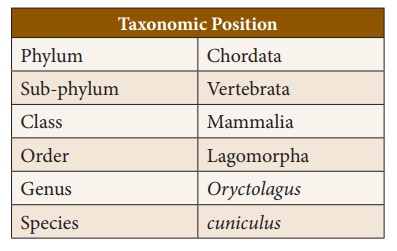
1. Habit and Habitat
Rabbits are gentle and
timid animals. They show leaping movement and live in burrows.
They are distributed
throughout the world. They are herbivorous animals feeding on grass and
vegetables like turnips, carrots and lettuce. Rabbits are gregarious
(moving in groups) animals
2. External Morphology
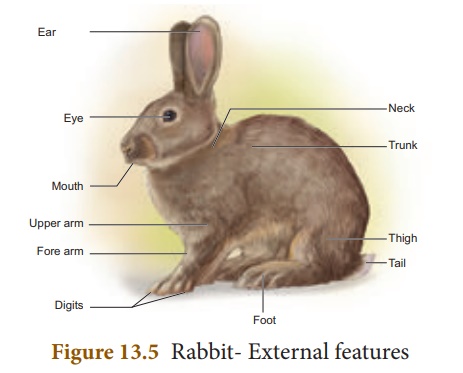
Shape, Size and
Colouration: It has an elongated and cylindrical body. Males and females
are of the same size. They grow about 45 cm in length and weigh about 2.25 kg
as adult. The colour varies from white to black and white. Body is covered with
fur which serves to keep it warm.
Body-division: The body of the rabbit
is divisible into the head, neck, trunk and tail.
Head: Head is ovoid, flattened
and bears a truncate snout. It contains mouth, external nares, eyes,
ears and vibrissae. The mouth is a transverse slit-like bounded by upper
lip and lower lip. Just above the mouth are two oblique openings called nostrils.
From each side of the upper lip tactile hairs or vibrissae (whiskers)
project outwards. A pair of large, movable external ear or pinnae is
situated at the top of the head.
Neck: The neck connects the
head with the trunk. It helps to turn the head.
Trunk: The trunk is divisible
into an anterior thorax and a posterior abdomen. In females, four
or five teats or nipples are present on the ventral surface
between the thorax and abdomen.
The trunk bears two
pairs of pentadactyl limbs. The forelimbs are shorter than the
hind limbs. All the digits bear claws.
The anus is present at
the posterior end of the abdomen at the base of tail. In females on the ventral
side a slit like vulva is present. In males penis is present in
the ventral side of anus. The male has a pair of testes enclosed by scrotal
sacs.
Tail: The tail is short. It is
used to give signals to other rabbits in the event of danger.
Integument (Skin): The integument forms the
outer covering of the body. The structures which are derived from it are hairs,
claws, nails and glands like sweat glands, sebaceous glands and
mammary glands.
Mammary glands are
modified glands of the skin. They secrete milk and help in nourishing
young ones. The sweat glands and sebaceous glands embedded in the skin regulate
the body temperature.
3. Coelom (Body cavity)
Rabbit is a coelomate
animal. The body is divisible into thoracic cavity and abdominal
cavity separated by transverse partition called diaphragm.
Diaphragm is the characteristic feature of mammals. Breathing movements are
brought by the movement of the diaphragm.
Lungs and heart lie in
the thoracic cavity, whereas, abdominal cavity encloses digestive and
urinogenital system.
4. Digestive System
The digestive system
includes the alimentary canal and the associated digestive glands .
The alimentary canal consists of mouth, buccal cavity, pharynx,
oesophagus, stomach, small intestine, caecum, large intestine and anus.
Mouth is a transverse
slit bounded by upper and lower lips. It leads into the buccal cavity.
The floor of the buccal cavity is occupied by a muscular tongue. Jaws
bear teeth.
The buccal cavity leads into
the oesophagus through the pharynx. Oesophagus opens into the stomach
followed by small intestine. Caecum is a thin walled sac present at the
junction of small intestine and large intestine. It contains bacteria that
helps in digestion of cellulose. The small intestine opens
into the large intestine which has colon and rectum. The
rectum finally opens outside by the anus.
Digestive glands
The digestive glands are
salivary glands, gastric glands, liver, pancreas and intestinal glands. The
secretions of digestive glands help in digestion of food in the alimentary
canal.
Dentition in Rabbit
Teeth are hard bone-
like structures used to cut, tear and grind the food materials. The

rabbit has two sets of
teeth. The existence of two sets of teeth in the life of an animal is called diphyodont
dentition. The two types of teeth are milk teeth (young ones)
and permanent teeth (in adults).
In rabbit the teeth are
of different types. Hence, the dentition is called heterodont. There are
four kinds of teeth in mammals viz. the incisors (I), canines (C),
premolars (PM) and molars (M). This is expressed in the form of a
dental formula.
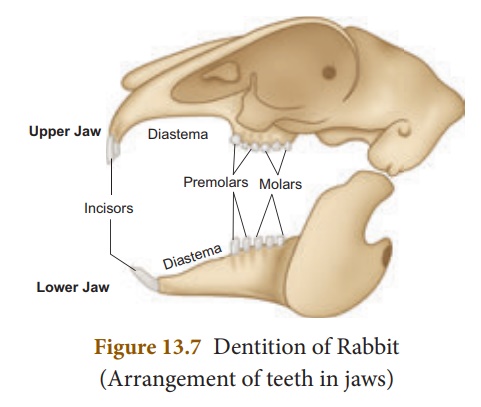
Dental formula is the simple method of representing the teeth of a mammal. The number of each kind of tooth in the upper and the lower jaws on one side is counted.
Dental formula is (I 2/1, C
0/0, PM. 3/2, M 3/3.) in rabbit which is written as 2033/1023. Canines are
absent. The gap between the incisors and premolar is called diastema. It
helps in mastication and chewing of food in herbivorous animals.
5. Respiratory System
Respiration takes place
by a pair of lungs, which are light spongy tissues enclosed in the
thoracic cavity. The thoracic cavity is bound dorsally by the vertebral column
and ventrally by the sternum, laterally by the ribs. On the lower side of the
thoracic cavity is the dome shaped diaphragm.

Each lung is enclosed by
a double membranous pleura . Atmospheric air passes through the external
nostril and nasal passages into the pharynx. From the pharynx it passes through
the glottis into the wind pipe.
The anterior part of the
wind pipe is enlarged to form the larynx or voice box with its
wall supported by four cartilaginous plates. Inside the larynx lies the vocal
cord and its vibrations result in the production of sound. The larynx leads
into trachea or wind pipe.
Tracheal walls are
supported by rings of cartilage which help in the free passage of air. The epiglottis
prevents the entry of food into the trachea through the glottis. The trachea
divides into two branches called the bronchi one entering into each lung
and dividing into further branches called bronchioles which end in
alveoli.
The respiratory events
consist of inspiration (breathing in) and expiration (breathing
out) allowing exchange of gases (oxygen and carbon dioxide). Inspiration is an
active process while expiration is a passive process.
6. Circulatory System
The circulatory system
is formed of blood, blood vessels and heart. The heart is pear shaped and lies
in the thoracic cavity in between the lungs. It is enclosed by pericardium,
a double layered membrane.
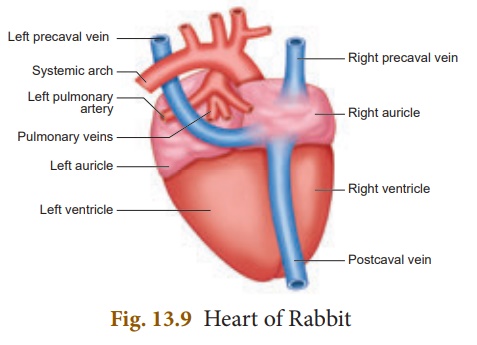
The heart is four
chambered with two auricles and two ventricles. The right and left auricles are
separated by interauricular septum, similarly right and left
ventricles are separated by interventricular septum.
The right auricle opens
into the right ventricle by right auriculoventricular aperture,
guarded by a tricuspid valve. The left auricle opens into the
left ventricle by left auriculoventricular aperture guarded by a bicuspid
valve or mitral valve. The opening of the pulmonary artery
and aorta are guarded by three semilunar valves.
The right auricle
receives deoxygenated blood through two precaval (superior vena cava)
and one postcaval (inferior vena cava) veins from all parts of the body.
The left auricle receives oxygenated blood from the pulmonary veins from the
lungs. From the right ventricle arises pulmonary trunk which carries the
deoxygenated blood to the lungs and from the left ventricle arises the systemic
arch (aorta) which supplies oxygenated blood to all parts of the body.
7. Nervous System
The nervous system in
rabbit is formed of the central nervous system (CNS), peripheral nervous system
(PNS) and autonomic nervous system (ANS).
CNS consists of brain
and spinal cord. PNS is formed of 12 pairs of cranial nerves and 37 pairs of
spinal nerves. ANS comprises sympathetic and parasympathetic nerves.
Brain is situated in the
cranial cavity and covered by three membranes called an outer duramater,
an inner piamater and a middle arachnoid membrane. The brain is
divided into forebrain (prosencephalon), midbrain (mesencephalon)
and hindbrain (rhombencephalon).
Forebrain consists of a
pair of olfactory lobes, cerebral hemispheres and diencephalon. The right and
left cerebral hemispheres are connected by transverse band of nerve tissue
called corpus callosum.
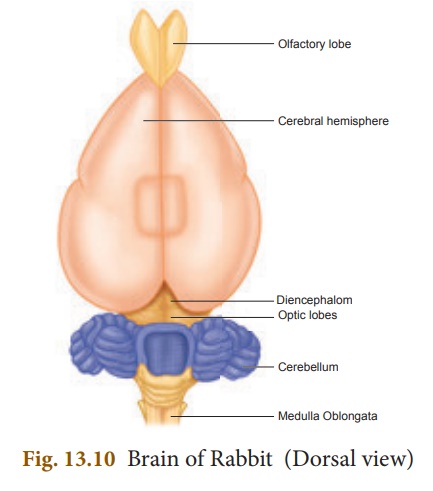
The midbrain includes
the optic lobes. The hindbrain consists of the cerebellum, pons varolii and
medulla oblongata. You will study about the details of mammalian brain in the
chapter on nervous system.
8. Urinogenital System
It comprises the urinary
or excretory system and the genital or reproductive system. Therefore, they are
usually described as urinogenital system in vertebrates.
Excretory system
Each kidney is made of
several nephrons. It separates the nitrogenous wastes from blood and excretes
it in the form of urea. Kidneys are dark red, bean shaped organs situated in
the abdominal cavity. From each kidney arises the ureters which open
posteriorly into the urinary bladder and leads into a thick walled muscular
duct called urethra.
Reproductive System
Sexual dimorphism is
exhibited in rabbits. The male and female sexes are separate and are
morphologically different.
Male Reproductive system
The male reproductive
system of rabbit consists of a pair of testes which are ovoid in shape. Testes
are enclosed by scrotal sacs in the abdominal cavity. Each testis consists of
numerous fine tubules called seminiferous tubules. This network
of tubules lead into a coiled tubule called epididymis, which
lead into the sperm duct called vas deferens. The vas deferens join in
the urethra just below the urinary bladder. The urethra runs backward and
passes into the penis.
There are three
accessory glands namely prostate gland, cowper’s gland and perineal gland.
Their secretions are involved in reproduction.
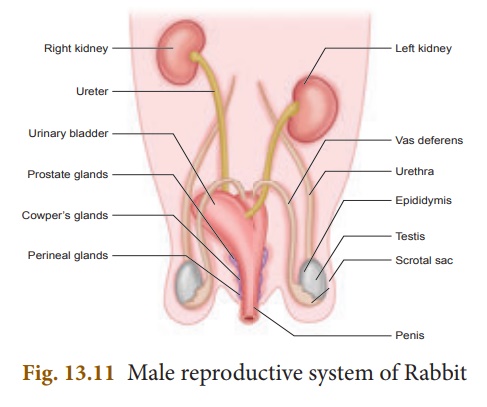
Female reproductive system
The female reproductive
system of rabbit consists of a pair of ovaries which are small ovoid
structures. They are located behind the kidneys in the abdominal cavity.
A pair of oviducts opens
into the body cavity by a funnel shaped opening from each side of the ovary.
The anterior part of the oviduct is the fallopian tube. It leads into a wider
tube called the uterus. The uterus join together to form a median tube
called vagina. The common tube is formed by the union of urinary bladder
and the vagina and is called the urinogenital canal or vestibule.
It runs backwards and opens to the exterior by a slit-like aperture called vulva.
A pair of Cowper’s
gland and perineal gland are the accessory glands present in
the female reproductive system.
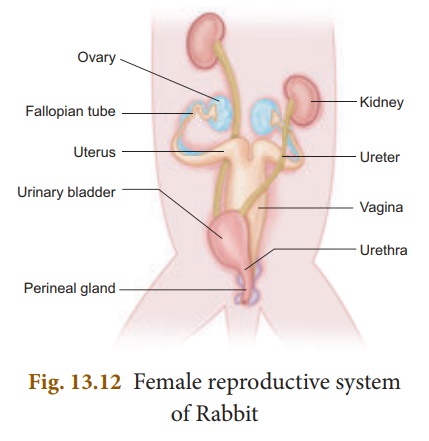
Related Topics